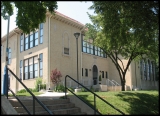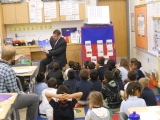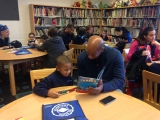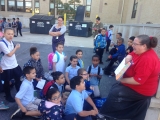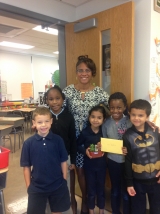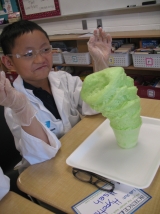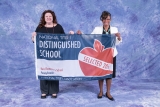-
Category 2
Selected in 2016
-
Grades: k - 5
School Setting: urban
Town Population: 60,000
Student Enrollment: 365
Student Demographics:
Black/African American: 17%
Teacher/Student Ratio: 1:24
White/Caucasian: 14.7%
Hispanic: 49.4%
Hawaiian/Pacific Islander: 0%
Asian: 7.8%
Native American: 0%
Other: 0%
% Reduced Lunch: 90.7%
% ELL Learners: 11%
Founded: 1936 -
PRINCIPAL:
Camille Hopkins -
CONTACT:
840 N Queen Street
LANCASTER, PA 17603
717-291-6268
cahopkins@lancaster.k12.pa.us
Ross Elementary School
LANCASTER, PA
"Together We Can" and we believe that everyone contributes and is responsible for a role in student success at Ross.
- Describe specific programs in place to ensure that families are involved in the success of your school and students.
-
Specific programs at Ross Elementary that ensure the success of students include:
• Welcome Wagon - invites new families that come to our school throughout the school year
• Ice Cream Social - brings the community and families together at the beginning of the year
• Barnes and Noble Family Reading Night - helps staff and families come together for fun and fund raising
• Dangerous Dads Math and Science Night - increases parent involvement with interesting family-led experiments
• Survey - recruits parents for various activities throughout the year
• Volunteer Coordinator - organizes and communicates to make sure all families are involved
- Describe the most successful activity your school has initiated to strengthen ties to your community.
- The Ross Parent Educator Group is one of the most successful Ross Elementary activities to strengthen community ties. The Ross Parent Educators Group is comprised of parents across the grade levels who represent the school and community needs. These representatives are responsible for helping to drive the School Improvement Initiative through their planning and preparation of school events that are focused on student achievement. This group meets monthly with the school leadership team and have been the catalyst for changing how community events are planned, prepared and staffed at Ross Elementary. These parents are the voice of the school.
- Describe your philosophy of school change or improvement.
- The philosophy at Ross is that everyone is valued and everyone has something to contribute. This starts with the principal and carries though to the parents as well as the crossing guard and chief custodian. The motto of our school district is "Together We Can" and we believe that everyone contributes and is responsible for a role in student success at Ross.
- What are your school’s top two goals for the next year?
- Our top two goals for next year are: academic growth and achievement for every student and strengthening the bond and relationship between the parents and the school.
- What is the single most important factor in the success of your school that others could replicate?
- The single most important factor in the success of Ross Elementary is the inclusive culture and climate. By building a cohesive parent partnership, all students know that all stakeholders are committed to their best interests as we learn and grow together. Over time, the staff, teachers, administrators, and families have come to trust each other for the shared commitment to the growth and achievement of our students.
- Describe the program or initiative that has had the greatest positive effect on student achievement, including closing achievement or opportunity gaps, if applicable.
- The change to maximizing small group instruction time has had a very positive effect on student achievement. This delivery style of instruction moves from a "stand and deliver" approach to a more purposeful and personalized learning plan where students are given what they need when they need it. All teachers and staff members are involved in this delivery model with small groups occurring across the school day but especially during intervention time. By connecting every decisions to data, we are targeted and purposeful in our lesson plans with individual student needs at the forefront.
- Explain how Title I funds are used to support your improvement efforts.
- Title I funds are used to support our school improvement efforts by supporting all parent initiatives in the building such as books, resources and educational materials for parents. Our Title I funds also support our instructional coach position and technology in the building.
- Identify the critical professional development activities you use to improve teaching and student learning.
- . One of the most impactful and critical professional development opportunities at Ross has been a series about the brain and how students learn. In the spirit of educating the whole child, this professional development helped us to know our students better as learners and thinkers. One powerful piece was about how trauma affects the brain. Because of this training, we have a plan for how to accelerate all learners through exploration, specifically in using STEM activities.
- Describe how data is used to improve student achievement and inform decision making.
- Motivating students with data, and involving them in collaborative decision making for their own learning has empowered our students to be life-long learners. Teachers and students have one on one data conversations to set the course of learning for the school year. These data conversations happen three times per school year. In between students are tracking their own growth with the use of graphs and progress monitoring. Teachers are using electronic binders and data walls in the classroom to make growth visual and attainable for students. At monthly PTO meetings, data is shared with parents so they have an awareness of what is happening in our school. At the school level, data meetings are held with the staff and leadership team to monitor progress. The reason we do this is to make sure we are in line with our school improvement goal.
- Describe your school culture and explain changes you’ve taken to improve it.
- Our school culture is fostered around student and parent collaboration with a focus on student growth and achievement. Our after-school activities and PTO meetings are designed to focus on parents' and students' needs. For example, our afterschool program includes enrichment activities along with remedial programs that fosters a culture of learning in our students. Our PTO meetings have been redesigned to mirror professional development sessions in which parents are walking away with tools and resources that extend learning outside of school. These workshops empower our parents to have a seat at the table more than just at conference time. Our parents are becoming true advocates, not only for our school, but for public education. The parent survey is another tool that is used to ensure that the school culture is in line with our parents' and students' needs.
Stats
-
Category 2
Selected in 2016
-
Grades: k - 5
School Setting: urban
Town Population: 60,000
Student Enrollment: 365
Student Demographics:
Black/African American: 17%
Teacher/Student Ratio: 1:24
White/Caucasian: 14.7%
Hispanic: 49.4%
Hawaiian/Pacific Islander: 0%
Asian: 7.8%
Native American: 0%
Other: 0%
% Reduced Lunch: 90.7%
% ELL Learners: 11%
Founded: 1936 -
PRINCIPAL:
Camille Hopkins -
CONTACT:
840 N Queen Street
LANCASTER, PA 17603
717-291-6268
cahopkins@lancaster.k12.pa.us


